评估土壤有机碳储量的单层等效土壤质量法:误差来源、简化和相关的可检测变化
IF 5.6
1区 农林科学
Q1 SOIL SCIENCE
引用次数: 0
摘要
为了长期稳定地监测土壤有机碳储量(SOCS),必须在等效土壤质量(ESM)层而不是深度层中确定 SOCS,这一点已得到公认。这项工作的重点是单层 ESM 方法、其成本、准确性和简化。为了简化 ESM 方法并降低成本,我们对瑞士西部的 393 块田地进行了采样,并对采样方法、SOCS 的方差来源和最小可检测变化 (MDC) 以及可能的简化进行了实验性质疑。使用凿岩机精确测定了地层质量,从而克服了进行无害环境管理 SOCS 评估的一个主要缺点。确定了等分样品数量与估计 SOCS 方差之间的关系。在固定深度和地层容积密度下取样会导致不可接受的误差,而且在变化被检测到之前,将 MDC 转换为年数会超过几十年。我们采用了一种新的程序来充分考虑层中的粗粒体积,当粗粒体积超过层体积的 10% 时,粗粒体积仍然是 SOCS 的主要误差来源,但不会影响变化的可探测性。在区域平均条件下,单层 ESM 方法提供的 MDC 与 SOCS 变化可探测性之前不到 10 年的时间相对应,与 0-30 厘米层相比,质量校正导致 MDC 的增加可以忽略不计。简化这种方法,使用该层的平均土壤有机碳含量进行质量校正只会略微增加 MDC,从而为大幅降低 SOCS 监测成本提供了机会。本文章由计算机程序翻译,如有差异,请以英文原文为准。
The single-layer equivalent soil mass method for the evaluation of soil organic carbon stocks: Sources of errors, simplification, and associated detectable change
It has been well established that for consistent soil organic carbon stock (SOCS) monitoring over time, the SOCS must be determined in an equivalent soil mass (ESM) layer rather than a depth layer. This work focused on the single-layer ESM method, its cost, accuracy and simplification. With the objective of simplifying ESM method and reducing costs, we sampled 393 fields in western Switzerland and experimentally questioned the sampling methods, the sources of variance and the minimum detectable change (MDC) of SOCS, and possible simplification. The layer mass was accurately determined using gouge-augers, thus overcoming a major drawback in performing ESM SOCS evaluation. The relationships between number of aliquots and estimated SOCS variance was determined. Sampling at fixed depth and layer bulk density resulted in unacceptable errors and MDCs exceeding several decades when converted to years before a change was detectable. We introduced a new procedure to fully consider the coarse fraction volume in the layer, which remains a major source of error on the SOCS when the coarse fraction volume exceeds 10 % of the layer volume, while not impacting the detectability of the change. The single-layer ESM method provided an MDC corresponding to less than 10 years before SOCS change detectability under the average regional conditions, and mass correction results in negligible increase in MDC compared to that of the 0–30 cm layer. Simplifying this method by using the average soil organic carbon content of the layer mass correction only slightly increased the MDC, thus providing an opportunity to decrease the cost of SOCS monitoring significantly.
求助全文
通过发布文献求助,成功后即可免费获取论文全文。
去求助
来源期刊

Geoderma
农林科学-土壤科学
CiteScore
11.80
自引率
6.60%
发文量
597
审稿时长
58 days
期刊介绍:
Geoderma - the global journal of soil science - welcomes authors, readers and soil research from all parts of the world, encourages worldwide soil studies, and embraces all aspects of soil science and its associated pedagogy. The journal particularly welcomes interdisciplinary work focusing on dynamic soil processes and functions across space and time.
 求助内容:
求助内容: 应助结果提醒方式:
应助结果提醒方式:


